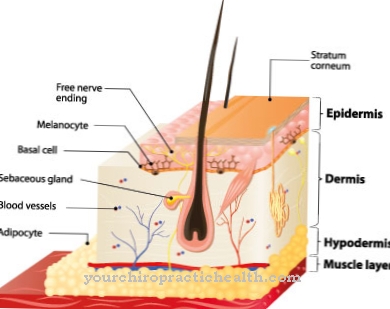A lymphatic filariasis is a tropical infectious disease that can be traced back to an infestation of the human lymphatic system with parasitic worms. Men represent a special risk group, especially for chronic lymphatic filariasis, which is associated with pronounced swelling in the genital area.
What is lymphatic filariasis?

© Yakobchuk Olena - stock.adobe.com
As lymphatic filariasis is a disease of the lymphatic system that occurs in the tropics and is the result of an infection with certain worms (so-called filariae) from the nematode family and which is transmitted by mosquitos.
Lymphatic filariasis manifests itself after an incubation period of one month to several years on the basis of acute inflammation of the lymph nodes and vessels, fever attacks, asthmatic complaints and allergic coughs (acute phase). In the advanced stages of the disease, lymphatic filariasis can lead to permanent damage to the lymph vessels, through which the lymph fluid can no longer drain and lymph varices (enlargements of the lymph nodes and vessels) form.
The migration of lymph fluid into neighboring structures leads to the development of lymphedema, which can take on extreme forms in the limbs, genitals and breast and lead to the elephantiasis characteristic of chronic lymphatic filariasis.
causes
A lymphatic filariasis is due to an infection with thread-like worms (filaria) from the family of nematodes (roundworms). The most important pathogens of lymphatic filariasis are Wuchereria bancrofti (Africa, Southeast Asia, Central and South America, Pacific), Brugia malayi (Southeast Asia) and Brugia timori (Indonesia).
The pathogens of lymphatic filariasis are transmitted by mosquitoes, so-called anopheles, which have previously been infected with worm larvae (microfilariae) from an infected person.
These mature in the mosquito's organism into infectious larvae. If a person is bitten by an infected mosquito, the microfilariae settle in the lymphatic system via the bloodstream, where they mature into sexually mature filariae, produce further larvae and cause the inflammatory reactions that are characteristic of the acute stage of lymphatic filariasis.
About three to eight months after infection, the microfilariae infiltrate the blood system of those infected with lymphatic filariasis for the first time.
Symptoms, ailments & signs
Lymphatic filariasis can manifest itself through very different symptoms. The first signs of the disease often only appear after months or years. Fever attacks and swollen lymph nodes appear no earlier than three months after infection. The obstruction of the lymphatic pathways can lead to inflammation of the lymphatic vessels and nodes.
In the absence of treatment, permanent damage to the lymphatic system can remain. Lymphedema, which causes swelling of the breast, genitals, and limbs, typically develops beforehand. The area around the infection is painful and causes an uncomfortable feeling of pressure when touched. In extreme cases, lymphatic filariasis can cause breathing difficulties and thereby trigger an asthma attack.
This is accompanied by general symptoms such as tiredness and fatigue. Those affected feel physically and mentally exhausted and are usually no longer able to go about their daily tasks. Outwardly, the disease of the lymphatic system can be recognized by the visible swellings and the sickly appearance of the person affected.
The doctor can determine increased blood counts for eosinophils, which clearly indicate a filariasis. If treated promptly, the symptoms usually subside quickly. As a result of the weakening of the immune system, however, secondary fungal or bacterial infections can occur that require independent therapy.
Diagnosis & course
There lymphatic filariasis is a tropical infectious disease, stays abroad in the endangered areas provide an initial indication of the diagnosis.
In addition, lymphatic filariasis is diagnosed based on the typical symptoms. A blood analysis can reveal an increased concentration of eosinophilic white blood cells in the serum (eosinophilia) and the antibodies specific for filariae. In the later course (chronic filariasis), microfilariae can be detected in the serum.
Since the pathogens infiltrate the blood mainly at night, the blood sample should be taken at this time. With an early diagnosis and timely start of therapy, the infectious disease has a good prognosis.
If left untreated, lymphatic filariasis leads to severe progression and very pronounced swellings (elephantiasis), which can represent a significant psychological burden for those affected.
Complications
With this disease, those affected primarily suffer from a very high fever. The patient is also very tired and tired. The resilience is also significantly reduced, so that there may be various restrictions in the everyday life of the person concerned. Furthermore, inflammations occur in the lymph nodes, which can lead to pain.
In severe cases, people have an asthma attack and generally have difficulty breathing. Severe breathing difficulties can also lead to a loss of consciousness, in which the affected person can also fall and injure themselves. There is also swelling. Not infrequently, the patients also suffer from psychological stress or depression. The patient's quality of life is significantly reduced and restricted by this disease.
Treatment of this disease is usually done with the help of drugs. There are no particular complications. However, some of the medications can cause side effects such as headache or fever. Treatment usually results in a positive course of the disease. However, the immune system has to recover after the treatment, so that the person affected is more susceptible to other diseases or infections.
When should you go to the doctor?
As soon as the typical signs of lymphatic filariasis are noticed, a visit to the doctor's office is advisable. If the symptoms do not resolve on their own after a few days or even get worse, a doctor must also be informed. It is best for those affected to speak to their family doctor immediately, who can clarify or rule out the filariasis. The appropriate treatment can then be initiated and further complications or long-term consequences can be averted.
If the symptoms occur a few months after a trip to one of the risk areas, a visit to a doctor is recommended. A mosquito bite on vacation should be clarified by a doctor immediately after returning to your home country. Warning signs should also be watched for after contact with a potentially infected person. Lymphatic filariasis is treated by a general practitioner or internist. In severe cases, it is necessary to visit a lymphologist or a specialist clinic for infectious diseases. Children must be presented to the pediatrician immediately if there are signs of lymphatic filariasis.
Treatment & Therapy
The therapeutic measures are primarily aimed at killing the pathogens with the help of anthelmintics (worming agents). These drugs contain specific toxins that negatively affect the pathogen's metabolism. Good results have been achieved in this regard with diethylcarbamazine, the drug being administered over several days depending on the body weight of the person concerned (e.g. 50 mg on the 1st, 3 x 50 mg on the 2nd day, 3 x 100 mg on the 3rd day and 3rd day) x 2 mg / kg body weight from the 4th to the 21st day of treatment).
Diethylcarbamazine, however, can cause side effects in the form of headache and fever. Ivermectin (avermectin) are also used for the treatment of microfilariae and albendazole (anthelmintic) against adult pathogens. Under certain circumstances there are microfilariae in the lymphatic structures that have already been encased in a capsule and accordingly do not respond to therapy.
In these cases, the lymphatic filariasis treatment must be repeated. Since the immune system is severely weakened in lymphatic filariasis, secondary infections (fungi, bacteria) may be present in some cases, which should be treated accordingly. Lymph drainage helps against the build-up of lymph. In the case of pronounced lymphedema (elephantiasis), surgical measures may be indicated in the case of lymphatic filariasis in order to remove the lymphatic congestion.
Outlook & forecast
The tropical disease has a favorable prognosis once medical treatment is sought. The administration of medicines usually leads to quick relief of the existing symptoms. After a few weeks, the affected person can be released from the treatment as cured.
Without the use of medical care, there is often a deterioration in general health. Delays in the healing process can be expected and breathing problems will arise. These can trigger anxiety or an acute and therefore life-threatening situation. For a favorable prognosis, a doctor should therefore be consulted at the first signs and physical changes.
With a stable immune system, the pathogens can usually be fought quickly. The prescribed drugs support the body's own defense system in the healing process and help to ensure that the dead pathogens can be removed from the organism as quickly as possible. Lymph drainage also helps against lymph congestion. With this treatment measure, the affected person is well positioned and has a good prospect of a speedy recovery.
If complications arise, surgical measures must be initiated. Surgery is risky and can cause complications. If the procedure goes smoothly, the drug treatment is continued afterwards. In order to make a good prognosis, an optimal diet should also help.
prevention
Against one lymphatic filariasis So far no vaccine is available, the preventive measures are limited to exposure prophylaxis. This consists of wearing long clothes, using mosquito nets, which may be impregnated with insect repellants, and using so-called reppelents (mosquito-repellent gels, sprays, lotions, creams) that protect against mosquito bites and thus lymphatic filariasis.
Aftercare
With this disease, people usually have a high fever. It comes to a permanent fatigue and exhaustion of those concerned. The resilience is significantly reduced, so that there can be many restrictions in everyday life. The quality of life of those affected is significantly impaired by the disease, so the help of friends and relatives is essential during this time.
In severe cases, those affected suffer from constant shortness of breath and asthma attacks, which is why they should avoid physical exertion as far as possible. It is not uncommon for those affected to suffer from severe depression and other mental illnesses, as those affected can no longer actively participate in life. The support of a psychologist can help to accept the illness better and to make dealing with it easier in the long term.
The treatment of the disease takes place in most cases with the help of drugs that should be taken according to the given dose. After the treatment, however, the immune system is weakened, so that the sick are more susceptible to infections, so it is advisable to avoid excessive action and return to everyday life gently.
You can do that yourself
In addition to drug therapy, filariasis patients can take some measures themselves to support the healing process. Physical rest and bed rest are particularly important. Especially in the first three to five days of the disease, the immune system should not be burdened any further so that the worms can be flushed out as quickly as possible.
A suitable diet also promotes recovery and also alleviates typical symptoms such as abdominal pain and nausea. The nutrition plan is best worked out with the help of a nutritionist. In the event of a lymphatic congestion, the weight should also be reduced. We recommend a healthy, low-salt diet combined with plenty of exercise (after the acute phase of illness) and avoiding stress.
If pain occurs, various naturopathic remedies can be used in consultation with the doctor. Alternative preparations such as belladonna, devil's claw or arnica may also help with headaches, fever and asthma attacks. If major complications arise in the course of the disease, one must go to a doctor again with the lymphatic filariasis. If the course is severe, it is imperative to refrain from further self-help measures, unless the doctor responsible suggests otherwise.

.jpg)

.jpg)









.jpg)

.jpg)
.jpg)











.jpg)